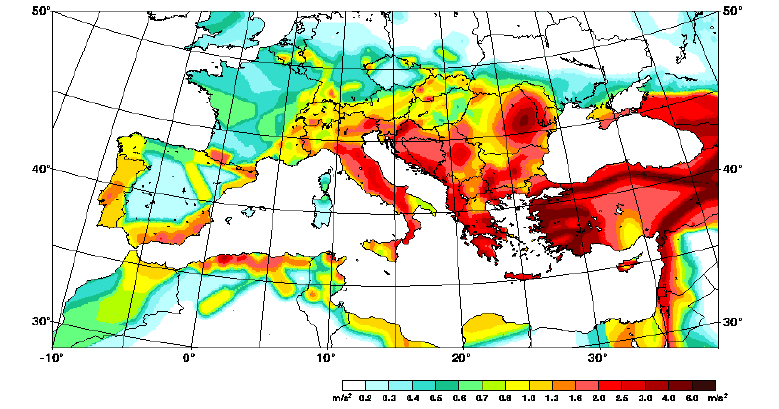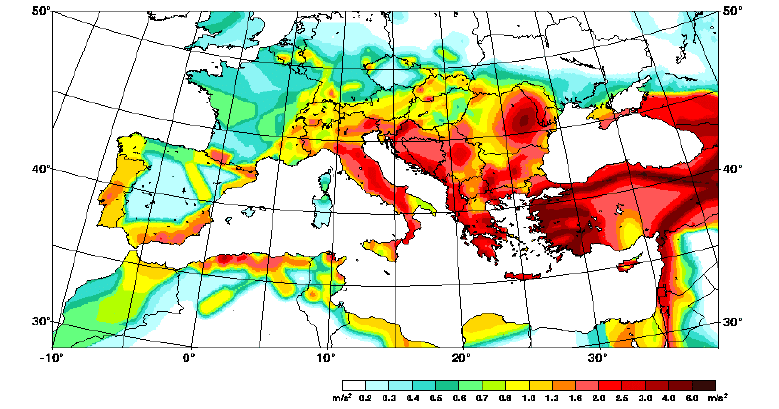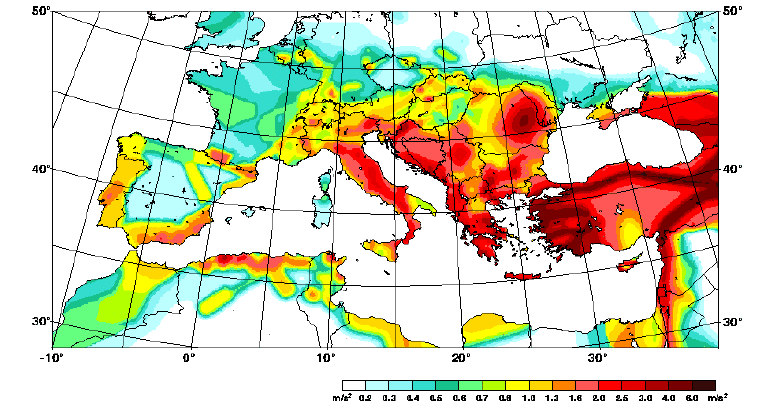The maximum ground acceleration that occurs during an earthquake is called maximum ground acceleration (PGA). The PGA is discussed for a specific location. It is the maximum acceleration at the location we considered for the project.
Ground movements due to an earthquake occur in any direction. For the sake of simplicity, we take vertical and horizontal acceleration into consideration during design.
In general, horizontal acceleration is crucial. However, this is not always the case. Especially if the location is close to the earthquake site, vertical acceleration is crucial.
How to consider maximum ground acceleration in design
The dominant parameter of Earthquake Design is the maximum ground acceleration. A correct estimate of the likely value of the PGA based on the payback period considered for the project is very important. Otherwise, we will get the wrong answer, that is, over-engineering or creating a structure vulnerable to failures caused by earthquakes.
These two aspects must be taken into account when calculating the seismic load.
- The available seismic data for the respective area. As we plan for a likely earthquake, it is very important to have an accurate date to estimate structural behavior. Insufficient or missing data causes problems and challenges for planners.
In these cases, we estimate this based on experience and information available near the location in question. In addition to the other relevant parameters, the distance to the plate boundaries can also be taken into account for this assessment.
- The second important parameter to consider is the payback period. It is taken into account when determining the force to be taken into account in the design of the structure.


Basics Behind the PGA
- PGA is taken into account in the vertical and horizontal layout of the project. The peak horizontal ground acceleration is generally critical.
- The PGA depends on the distance from the structure and the location where the earthquake occurs. The place of origin of the earthquake is called the epicenter.
- Furthermore, PGA depends on soil geology, earthquake depth, etc.
- PGA represents the multiple of the acceleration of gravity (g = 9.81 m/s 2 ). Maximum ground acceleration can be specified as 0.1 g, for example.
Importance of the PGA
We feel the acceleration. Not only earthquakes, but also wind causes noticeable acceleration when it exceeds a certain level. According to general considerations, the following can be considered critical areas of human well-being.
However, these values do not have to apply differently to the building. We need to consider acceleration depending on the factors discussed above in planning.
| acceleration | Multiples of damage | Damage/comfort level |
| 0.01m/ s2 | 0.001g | People feel movement |
| 0.2m/ s2 | 0.02g | People lose their balance |
| 5m/ s2 | 0.50g | Very high acceleration. Well-designed buildings would survive with a short enough attenuation period. |
The following table is a Wikipedia excerpt based on acceleration variation and other relevant parameters published by the United State Geological Survey.
| Instrumental intensity |
acceleration (G) |
speed (cm/s) |
Perceived tremor | Possible damage |
| I | <0.000464 | <0.0215 | I didn't feel | None |
| II-III | 0.000464 – 0.00297 | 0.135 – 1.41 | Weak | None |
| 4 | 0.00297 – 0.0276 | 1.41 – 4.65 | Light | None |
| v | 0.0276 – 0.115 | 4.65 – 9.64 | Moderate | Very easy |
| SAW | 0.115 – 0.215 | 9.64 – 20 | Strong | Light |
| VII | 0.215 – 0.401 | 20 – 41.4 | Very strong | Moderate |
| VIII | 0.401 – 0.747 | 41.4 – 85.8 | Difficult | Moderate to severe |
| IX | 0.747 – 1.39 | 85.8 – 178 | Violent | Difficult |
| X+ | > 1.39 | > 178 | Extreme | Very difficult |
Relationship between PGA and earthquake magnitude
It appears that there is no direct relationship between the maximum ground acceleration and the magnitude of an earthquake. The PGA is in place and the magnitude varies from location to location for the same earthquake. However, there appear to be empirical connections.
The PGA depends on numerous factors, such as the distance of the structure from the epicenter, the geological conditions of the terrain, the shape of the wave, the type of earthquake, the magnitude of the earthquake, etc.
The following rearranged seismic data in the earthquake report also shows how difficult it is to establish a direct relationship between the maximum ground acceleration and the magnitude of the earthquake, measured on the Richter scale.
| Maximum PGA; one direction | Size | depth | Year and location |
| 1.46G | 6.4 | 17.9 kilometers | 2022 Ferndale earthquake |
| 1.26G | 7.1 | 10km | 2010 Canterbury earthquake |
| 1.25G | 6.6 | 8.4 km | 1971 Sylmar earthquake |
| 1.04G | 6.6 | 10km | 2007 Chuetsu offshore earthquake |
| 1.0G | 6.0 | 8 kilometers | Christchurch earthquake in December 2011 |
| 0.65G | 8.8 | 23km | 2010 Chile earthquake |
| 0.18g | 9.2 | 25km | 1964 Alaska earthquake |
Source: Wikipedia

